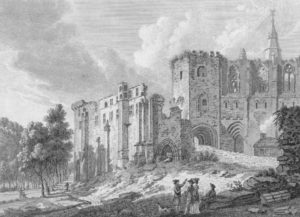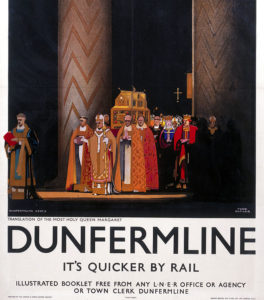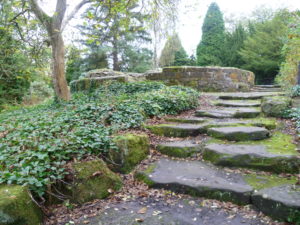A London North Eastern Railway promotional poster of Dunfermline Abbey. Credit: SSPL/Getty Images
Back in the mid-90s, somebody or other produced a list of the 10 most boring towns in Scotland, which was duly picked up by the papers. I don’t remember which bleak pile of bricks came first, but I do remember the perverse pride I felt upon learning that my hometown of Dunfermline had placed fifth. That seemed a more profound manifestation of dullness than landing the #1 spot would have been; to “win” would mean appearing exceptional, and thus, paradoxically, at least slightly interesting.
That feeble fifth-place ranking captured the depressing atmosphere of weary run-down rubbishness in which we who lived in the “Auld Grey Toun” were marinaded. Our local bookshop and cinema had closed down by that point, so there was not a lot in the way of culture or entertainment, although — to be fair — we did get the panto every year and I once saw Fife’s premier Frank Zappa tribute act, Frank McZappa, play in a pub. Speaking of pubs, we had no shortage of those, and we were also lucky enough to have a swimming pool, bingo hall and some ruins. You might say it was a bit like Waiting for Godot, only we’d all long since given up waiting.
Not that long ago, I would have ridiculed the very notion that Dunfermline contained any mysteries worth bothering about. My teachers did at least try to instill some civic pride: as a child I was taught that my hometown was Scotland’s “ancient capital”; that in the 11th century an important king named Malcolm Canmore built a tower there; that his wife Margaret became a famous saint; and that Robert the Bruce, the last Scottish king to defeat the English in battle, was buried in the Abbey. After that, nothing much seemed to happen for 500 years, until Andrew Carnegie was born. But he had to leave Dunfermline to become successful: a fact that was not lost upon any of us.
That’s a decent amount of history for a small town that nobody visits. And later, I learned more: Charles I, later to attain some notoriety, was born in Dunfermline’s royal palace; and Robert Henryson, a major medieval poet, had been headmaster at the high school.

And yet even to a child it was obvious that Dunfermline was centuries past its prime. Malcolm’s Tower (the “dun” in Dunfermline) was a circle of old bricks in on top of a hill frequented by nobody. The Abbey nave had fallen into disuse after a new bit was added in the 19th century, while all that remained of the royal palace was a wall — which was a great backdrop for staging mock-World War II battles, until Historic Scotland put a gate on it and started, rather too optimistically, charging for entry.
Saddest of all was Saint Margaret’s Cave, a once-sacred grotto, which was accessed through a shed in the car park behind The City Hotel, and which was closed for much of the year (the shed’s design drew heavily upon the “public toilet” school of architecture.) I was told by a guide that the city council had almost filled in the cave completely when they were putting in the car park, but a grassroots campaign had prevented that outrage. Thus even our history seemed a bit rubbish; the town was a place where people did things that were forgotten, or left to achieve greater fame elsewhere. I turned my back on Dunfermline in favour of Moscow, and then Texas, and for a long time I thought that seeing family was the only possible reason for visiting the place.









Join the discussion
Join like minded readers that support our journalism by becoming a paid subscriber
To join the discussion in the comments, become a paid subscriber.
Join like minded readers that support our journalism, read unlimited articles and enjoy other subscriber-only benefits.
SubscribeYou seem shocked by the vandalism of your ancestors, but in truth the 16th century Scotch Reformation was one of the most architecturally destructive in European history.
Whereas in England only two Cathedrals were ‘lost’ in this period nearly everyone of Scotland’s thirteen were unroofed and trashed. The most important loss being St Andrews, the seat of the Primate of Scotland and the only Cathedral that could bear comparison with most of those in England.
Additionally all of the great Abbeys suffered the same fate including perhaps the greatest, Dunfermline, as you so eruditely describe. Thus Scotland has very few extant Royal tombs, unlike the plethora that still exist in England. If it is any consolation things were even worse in Ireland and perhaps also Wales.
Please don’t encourage them. Those are not just kings of Scotland but of these British Isles, rightfully a source of shared affection, just like the kings of Wales and of the Heptarchy ought to be.
These were Scots Kings, who ruled before the Union of the Crowns in 1606
A bloke from Dunfermline told me that as a young man he had always gone up the road to Jackie Os night club in Kirkcaldy, because “there was a better class of woman”. A rather damming indictment I thought.
Night Magic was the club in Dunfermline if I remember correctly but I think buses from all over Scotland used to go to the improbably named Jackie O’s so I’m fairly sure it would have been hoaching.
Wonderful article – thank you. I was born and now live back in Sydney Nova Scotia (New Scotland) and have had the same experience with our history. No appreciation of it when I was younger, but over the decades have realized it is actually quite interesting (considering North America’s short history – it would be nothing by Scottish or European history standards)
`The King sits in Dunfermline town, drinking the blood-red wine`
Surely one of the greatest opening lines in poetry.
I moved from England to Dunfermline for five years in the early 2000s. I thought the town and its history fascinating and was surprised that so little was made of its tourism potential. I too was disappointed by the rubbish along what should be an enchanting walk along the burn.
Frank McZappa was an amazing wee outfit. Oh and it’s the yoonatic lot that need a wee hand up now. Yes, the sad fact is that it’s the union and the wars they so love that is our history now. A casual reference to Bruce’s spider will draw a blank look from the under 40s. Oh and Dunfermline wimin rock. Great article.